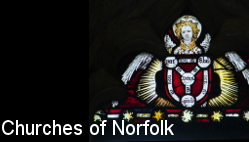| |
|
All
Saints, Oxwick There is
something particularly poignant about a church whose
ruination is recent. Until 1940 this was a working
building, but it fell into disuse and was declared
redundant in 1946. In those unsentimental days it befell
the fate of all such abandoned churches, having its roofs
removed in a formal act of dereliction. There must be
people alive today who remember that happening.
Although not far from a back lane between Colkirk and
Whissonsett, there is no proper road to the church and no
real village. The church is concealed from the road by a
couple of cottages, that's all, but enough to make it
easy to forget that it was there. When Bill Wilson
visited for the Pevsner revision in 1991 he found it
overgrown and inaccessible, a mass of ivy and elder,
quietly going back to nature. And that might have been
the end of the story. Step in the heroes of Norfolk
County Council, who have made it their business to save
and consolidate twenty or so of the most significant of
Norfolk's hundred-plus ruined churches. In 1993, the ruin
was completely cleared of overgrowth, and the walls
topped off to prevent further decay. The graveyard was
also cleared, and several of the graves showed signs of
being recently maintained when I visited in April 2006.
Oxwick had obviously lost its tower some time in the 18th
or early 19th Century, and the base of the tower was
converted into a shack-like vestry. This looks most odd
now that it is roofless. Also odd is the arrangement of
windows in the west wall of the nave. There are two high
up that must once have flanked the tower which are
mysterious. The single surviving window headstop on the
south side shows that this might have been quite a grand
place once. Poignant beneath it is a fine 18th Century
headstone for Thomas Lawrence, with a skull with crossed
bones flanked by hour glasses to remind us of our
mortality, as if the ruined church wasn't enough.
At the bottom of this page are two photographs kindly
contributed to the site, which are both haunting in their
own ways. Louisa Sugden sent me the shot of the view
looking east inside the church, probably some time in the
late 19th Century, and Steve Greef sent me a photograph
of his great-grandmother, Mary Greef, standing outside
Oxwick church with her donkey at the end of the 19th
Century. Where she is standing is now completely
overgrown, and the view is impossible today. But here
they are, two haunting memories of of a tiny place in
Norfolk as it was before we lost it.
Simon Knott, February 2021
Follow these journeys as they happen at Last Of England
Twitter.
|
|
|
